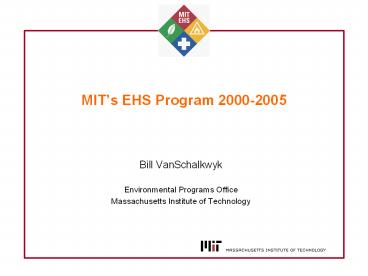MIT - PowerPoint PPT Presentation
Title:
MIT
Description:
Environment- Conserving Air, Water, Soil, Plants, Animals, Wildlife, Our ... Controls/Preventative Measures/Compliance Oversight Linchpin ... – PowerPoint PPT presentation
Number of Views:124
Avg rating:3.0/5.0
Title: MIT
1
MITs EHS Program 2000-2005
- Bill VanSchalkwyk
- Environmental Programs Office
- Massachusetts Institute of Technology
2
Reported New Program to HERUG- 2001 EHS
Management System Concept
- Now 75 Complete
- No Longer a Concept
- Reporting Today on Progress Outcomes
3
Todays Report
- What is EHS?
- Intent- Why a Management System?
- How- The EHS Development Process
- Concept in 2001 and Outcome in 2005
- Technology (SAP and other) Support
- Opportunity and Barriers
- Expectations as We Complete Build Phases
4
What EHS is (Environment, Health, Safety)
- Environment- Conserving Air, Water, Soil, Plants,
Animals, Wildlife, Our Community (causing no
damage) - Health- Preserving Human Health both Chronic and
Acute (preventing illness) - Safety- Preserving Human and Community Safety/
Well Being (preventing injury)
5
Intent Why an EHS Management System at MIT?
- Professional Management
- Manage Cost (2nd and 3rd order)
- Lower Risk
- Avoid/ Mitigate Incidents
- Address Local Culture and Issues
- Enable- not Impede
6
Scope of EHS Management System
- 43 Departments Laboratories and Centers
- Facilities, Student Life, Athletics
- Cogeneration Facility, Research Nuclear Reactor,
Linear Accelerator - Campus Community 20,000 people
- 3351 Lab Rooms (2481 Campus, 870 MIT LL)
- 575 Principal Investigators (incl. LL)
- 49 Departmental EHS Committees
- 40/- Local (DLC) EHS Coordinators
- 18 Central (EHS Office) Lead Contacts
7
The EHS Development Process
Sustainability Involve Faculty, Researchers,
Administration and Students in EHS-MS Systems
Design to Ensure Client Satisfaction, Utility,
Widespread Ownership
Institute Direction
Senior Officers Provost Chancellor Executive
Vice President
Leadership and Oversight
Work Production
Heavy Lifting
Working Committee EHS Management System Design
and Implementation
Project Team
Project Manager
Students
Faculty
Senior Administration
Researchers
Rep. Faculty, Researchers, Administration
Projects
8
Concept 2001and Results 2005( Major
Technology Support Indicated)
- 2001 Design Element
- EHS Policy
- Organization
- Inventory
- Training Program
- Auditing Program
- Incidents
- EHS Manual
- Pollution Prevention
- Measurement
- Third Party Audit
- 2005 Outcome
- Policy Complete 12/01
- Installed 06/2002
- Alternative Implemented 12/2002
- Interim System 09/2002
- Began 04/2003
- Developing Now
- Went Live 06/2004
- Planned 10/2005
- Mgmt Reports Planned 4/06
- Planned 06/2006
9
2001 Inventory Proposal
10
Inventory Alternative
- Central and Departmental Objectives of Inventory
- Purchasing System Not Optimized for Inventory
- Inventory Not Providing EHS Second Order Data
Needed - Positioning MIT to be Prepared for a Regulatory
Imposed Inventory - Limit to Prospect of Internal Marketplace
11
Alternative PI/Space Registration,
- PI/Space Modeled on Radiation Biological
Programs - Based Upon
- Who is in Charge,
- What Areas Under Control,
- Hazard Potentials in Area
- 3300 Areas Registered
12
Inventory Support, Proactive P2 Program
- Local Inventories Popular
- Position MIT to Expand Institute-Wide
- Central Support to Keep Awareness High
- P2 Encourages Less Hazardous Use
- Student Studies
- Possible Integration w/ Procurement
13
Training Needs Determination
- Not Possible to Determine Needs by Job
Description - Several Thousand Personnel Not Classified
Employees (Students) - Needs Assessment Based Upon Activities
- Over 6,000 Persons (Users) of Program to Date
14
Training Implementation
- Needs Based Approach
- Web Based Modules
- Live Training Options
- Central Record Keeping
- Non SAP Now- But Conversion Planned for
Appropriate Components - Subset of Institute-wide Training Initiative
15
Findings-
- Results of
- Audits,
- Incidents
- Track Corrective Actions
- Notify Affected Parties
- Initiates Work Orders (Integration)
- Paper System In Conversion Now
16
SAP Implementation Notes
- EHS Business Processes Not Mature
- - Business Process Development is Concurrent
Design-Build Due to Regulatory Requirements - Roll Out New Process Manually and Paper Based
(Audit) - Enforce and Re-Enforce Lock In of Business
Processes (Vote on Lock-in) - Make Hard Decisions on Enhancements and BP Changes
17
SAP Implementation Notes
- Academic Development Process Different from Tech
Development Process - Central EHS Office New to Entire Business Process
Development and Modeling - Nature Of Research Culture is One-off, Not Always
Systematic, and Change Oriented - Technology Personnel Seek Stable, Mature,
Tried-Tested Processes to Model and Support - Need to Collaborate at All Levels for Groups to
Learn How Each Other Operates - Need Small Success Early to Ignite Change and
Innovation
18
SAP Implementation Notes
- Academic DLCs Decentralized- Not a Monolithic
Client - No Single Person Can Represent the Client
- SAP Implementation Methodology Suggests a BP
Expert Join Development Team - EHS Office Unable to Satisfy This Need with an
Wide-Knowledge Resource - Variation to this Process- IST Attend EHS
Meetings, EHS Attend IST Development
19
SAP Implementation Notes
- PDA Support
- Desired by Clients especially for Inspections
- Determined Support in EHS Committee
- Planned for later Deployment
20
Future Activity
- Future Business Processes
- Pollution Prevention
- Local Inventory Support
- TSCA and other Regulatory Programs
- Retirement of Local and EHS Office Systems
- Select Agents
- Bio and Rad Protocols
- Asbestos Sampling and Abatement Data
- Balanced Scorecard Approach
21
- Bill VanSchalkwyk
- MIT Environmental Programs Office
- Billv_at_mit.edu
- Hal Burchfield
- MIT Information Services and Technology
- Hburch_at_mit.edu































